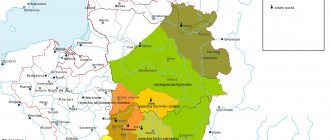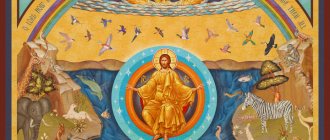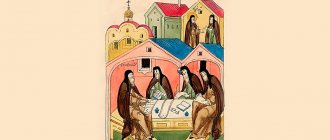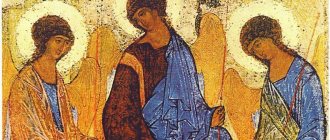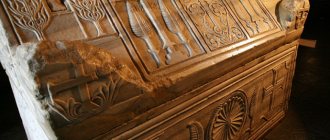Updated July 22, 2021
Hello, dear readers of the KtoNaNovenkogo.ru blog.
“The legend is fresh, but hard to believe...” This catchphrase from A.S. Griboyedov’s comedy “Woe from Wit” has firmly entered into our everyday speech.
It means that a person has doubts about the reliability of the information presented.
Why is the word “tradition” perceived in this particular context? Let's clarify the meaning of the term and find out whether the legends are worth believing.
Tradition: definition, concept, meaning
“The legend of deep antiquity, the affairs of days long past.
“Every Russian-speaking person has heard, seen, and read these lines since childhood. This is how Alexander Pushkin began his work “Ruslan and Lyudmila”. Are his tales really legends? To know for sure, you need to understand the concepts. Poetry is poetry, fairy tales are fairy tales, but what does the word “legend” mean? We will consider the definition and special features of this phenomenon in our article.
Examples of historical distortion of Tradition
The Roman Catholic Church focuses on the earthly authority of its head, the Pope, thereby distancing itself from other Churches and denying Christ as the true head of the Church. The tradition of the Catholic Church is also developing, not fixed, which means that some fatalities can be dogmatized (for example, the dogma of the infallibility of the Pope when he speaks from the pulpit was established in 1870). The deviation of the life of the Catholic Church from spiritual development into a social direction led to the legalization of celibacy (an order for the clergy to remain unmarried), which resulted in a decline in morality among the clergy and the appearance of illegitimate children. The usurpation of the people by the Church gave birth to the Reformation. The main motives of the Reformation were to return the Church “to normal”, in ancient Christian times. The centralization of power in the Catholic Church among the reformers was transformed into parliamentarism and parity, practicing a universal priesthood. The prohibition of Catholics from reading the Bible in their native language gave rise to a desire among reformers to study it, which we see even now. The most important thing is the rejection of the Holy Tradition, which the Protestants wanted to look at through the eyes of Christ, who told the Pharisees that they were hypocrites and seeking profit by adhering to the tradition of the elders (Matthew 15:2). The Reformers changed those aspects of the Catholic Church that were most distorted and different from the aspects of the Church of early Christian society. The reformers tried to restore them in inverse proportion to the vector of their change in Catholicism. This led to a diverse palette of creeds and doctrines: from the rejection of Tradition to its acceptance and from the hierarchical clergy to ridicule of God's institution in the form of the ordination of pagans, atheists, homosexuals, etc.
Tradition as a genre
We will begin our acquaintance with the world of folk legends with the definition of the concept itself. So, various sources give us the following.
Tradition is a prosaic folklore genre, the plot of which is historical facts in the folk interpretation. People's legends are not associated with the fairy tale genre, although sometimes events resemble mythical or fairy tales.
Legends in literary theory are usually divided into two large groups according to the type of plot: historical and toponymic.
Ways to return to Tradition
One of the criteria of Orthodoxy is the attitude towards the Holy Tradition and its observance: dogma, liturgical heritage of the Church, church images, the Cross, patristic heritage, apostolic succession in the priesthood. A Church that denies Sacred Tradition in its entirety cannot be called a Church. And vice versa, a religious organization that accepts the entire experience of the Church, including Sacred Tradition, is the True Church. This is what we should strive for. The reunification of fallen communities with the Church occurs through the renunciation of their doctrines and the full acceptance of the doctrine of the Orthodox Church. In the doctrinal aspect, compromise is impossible, as is customary in politics, because the Church in her earthly life is guided by the unchangeable will of God; states are created by communities that have different priorities (sometimes two states have mutually exclusive priorities). Of course, compromise is possible in case of cultural differences. It is important to find the cause of the discrepancies and try to resolve it in the spirit of Church Tradition, excluding human ambitions, remembering the words of the Apostle Paul: “If possible, be at peace with everyone” (Rom. 12:18).
Legends are part of oral folk prose
We learned what tradition is. The definition gave us a general idea. Let's talk about one feature of this genre. It is noteworthy that legends are a genre of oral folk art. This means that the stories heard today were created hundreds of years ago and passed from mouth to mouth. By the time the legend was recorded on an information medium, dozens or even hundreds of transformations of the plot and images could have occurred.
The works of the famous Greek poet Homer, “The Iliad” and “Odyssey,” which have an incredible size, were also transmitted orally. They also described historical events, embellished and somewhat modified. This shows some similarity between these creations and newer legends.
As a genre of oral prose, legends are admired for their long history. Fortunately, or maybe not, distributing them in recorded form is much easier these days. We should appreciate every word and legend that provides important spiritual knowledge about our ancestors.
Comparison with other folk prose genres
Traditions can sometimes be mistakenly defined as legends or epics. To avoid this, let's call this pattern: the plots of legends are aimed at explaining the origin of some cultural or natural phenomenon. They often give a certain moral assessment to the events described. A legend is a folk retelling of a story involving widely known or locally famous heroes.
People's legends differ from epics in content, characters (historical figures: robbers, rulers, ordinary people, artisans), and the participation of real personalities known in a certain area who have become mythological heroes.
Characteristic of this genre of folklore prose is a third-person narration about events related to the past. The narrator of the legends was not an eyewitness to the events, but conveys a story heard from third parties.
Main types of legends. Ideological and artistic originality of historical legend.
1. Tradition is an oral epic story widely known among the people with an emphasis on authenticity, an explanation of the real facts of past history, life, and the names of individual localities. The people themselves noted authenticity as the most characteristic property of legends; they call them “byvalshchina”, “bylyam” and also “pre-syulschina”, that is, a story about ancient times, events that happened in “pre-syulschina times” to the present time.
2. Traditions are characterized by the intensity of their ideological and emotional impact. They are brief and have the form of a strict epic narrative. The authenticity of the message is not in doubt, no matter how incredible it may be in itself. The formula “old people say” is a common reference of those who report the tradition.
3. Definition of genre . Folklorists have not yet given a sufficiently satisfactory and substantiated definition of legends. Often in scientific literature, traditions and legends are mixed, although these are different genres. This is explained by their proximity, as well as the presence of transitional forms, some of which are closer to legends, while others are closer to legends. Legends are popularly called “bylya” and “byvalshchina”. They are characterized by historical themes. Traditions preserve the memory of events and figures of national history.
Among the different legends, two large thematic groups : historical legends about memorable historical events and persons, and toponymic legends about the foundation of different cities, the origin of their names, names of tracts, mountains, etc.
Toponymic legends explain the origin of names, and even the very appearance of mountains, tracts, and other noticeable places on earth.
Historical legends were more fortunate than any other genre; they were included in the chronicles by the first literate people. They included historical legends related to the reign of the Kyiv princes and the battles waged by the Eastern Slavs. Legends about the tormentors of the Slavs, about the Khozar elders who predicted the strength and power of the Kiev state, about Oleg’s campaigns against Constantinople, about the death of Oleg, about Princess Olga’s revenge for the death of Igor, about the matchmaking of Prince Vladimir to Rogneda, historical legends also include legends about Razin and Pugachev, about the outstanding tsars Ivan the Terrible and Peter the Great.
HISTORICAL TRADES – narration. folk poetic genre creativity (folklore), the texts of which contain information about real life. persons and events of the past. The origin is the stories of eyewitnesses, which, when transmitted to others, gradually move away from the facts. fundamental principles, undergoing processing according to the laws of the genre and adhering to the oral narrative. traditions of the people. In this case, fiction is most often unconscious; the narrator focuses on the truthfulness of events and the reality of the characters, with this I.p. close to myths and realities.
The historicism of legends lies primarily in the fact that they have a historical basis. In chronicles and folk traditions, legends play the role of a reliable historical source; they are referred to as true evidence of the past of their native country. The historicism of legends also lies in the fact that over time, changes occur in the life content and form of works. Their themes, plots, motives, characters, and the nature of the depiction of events and persons are constantly updated.
What is specific in legend is also the reflection of reality: attention to details, particulars, details of the past.
4. In the repertoire of Russian legends, the following main cycles can be distinguished: ancient legends, legends about the “just king”, legends about the leaders of popular movements, legends about robbers and treasures.
ü The most ancient legends appeared at a time when the supernatural characters of tribal myths were replaced by ordinary people (A. N. Afanasyev called this process “the bringing down of the gods from heaven to earth”). Legends tell about the settlement of the Slavic tribes and about their ancestors, whose names were associated with the name of the tribes themselves.
ü Legends about a just tsar are associated with the names of Ivan IV (the Terrible) and Peter I.
ü Legends about the leaders of popular movements complemented the utopian dream of the people about a just king.
In folklore, the earliest historical image of a people's leader is the ataman of the Siberian Cossacks, Ermak Timofeevich, who defeated the Siberian Khan Kuchum. The cycle of legends about Ermak developed simultaneously with the cycle about Ivan the Terrible (at the end of the 16th - beginning of the 18th century). The image of Ermak absorbed the epic features of epic heroes and was colored by popular ideas about the “noble robber”.
ü Legends about robbers and treasures were told everywhere in Russia, since places associated with robbers and places where they allegedly buried treasures were known everywhere. The typological image of the “noble robber” (the hero robs the rich and stands up for the poor) appeared in numerous local variations.
Tradition, although it has a “free form”, in which there is no specific model for constructing a work, is not without an internal structure, principles of ideological and artistic organization of the work: the consolidation of all narrative material by one plot episode, one main character, the creation of whose image both the plot and expressive means are subordinated to. . Legends also have an aesthetic function, which is manifested in the unusualness of the plot situation, the idealization of the positive hero, and the use of special expressive and figurative means.
Question 25. Ideological and artistic originality of the legend genre.
1. Legend - stories expressing Christian concepts and ideas, formed into a separate genre system.
Legend (from Latin legenda - “that which should be read) is originally the life of a saint, written to be read on the day of his memory. The term originated in Catholic writing. In the XIII – XV centuries. In Europe, numerous consolidated collections of legends in Latin (“Golden Legend”) have been developed.
Later, the legend is a religious and didactic narrative, parables about animals, plants, and objects of Christian worship. In modern everyday meaning, a legend is often called, regardless of genre, works that are distinguished by poetic fiction and at the same time claim to be authentic.
In folklore, a legend is an oral folk story that has become a tradition, based on a fantastic image or performance that is perceived by the narrator and the listener as reliable. The basis of a legend is always a “miracle”, and it tells both about the past, the present, and the future. (A.N. Afanasyev, K.V. Chistov)
Legends are prose works in which events associated with inanimate natural phenomena, the world of plants, animals, and people are fantastically understood; with supernatural beings. (B.P. Kirdan)
2. V. Ya Propp considered the legend an intermediate genre, the starting point was the fairy tale
. Those. legend borders on epic, fairy tale and legend, all of them emerge from myth and smoothly flow into each other.
3. The main functions of legends: explanatory and moralizing.
4. Legends are associated with Christian ideas, but they also have a pagan basis. In legends, man turns out to be immeasurably higher than evil spirits
.
main property as a genre was the affirmation of the moral and ethical norms of Christianity or ideas that arose under the influence of an inspired attitude towards faith, although understood in a worldly, everyday, everyday way. The legend as a genre stands out quite clearly among the types of oral prose.
The legend is always based on the Christian worldview, although it connects it with everyday concepts and ideas. The degree of influence of Christian doctrine on a legend varies - from decisive to very superficial, but there are no legends free from the Christian faith. For this reason, already the first scientists proposed a classification of legendary plots and motifs, taking as a basis their proximity to the themes and content of written works.
5. The main types of legends (B.N. Kirdan)
:
· etiological – provide knowledge about the world around us;
· religious and edifying – about God, etc. Here a special collection of legends about holy fools : a) about the spinner at the factory, Maximka the Prosperous; b) about Vasenka - a perspicacious person; c) about the artist Efim Chestnyakov. In oral traditional Christianity
legends could take the form of fairy tales (
legendary tales ) - “Marko the Rich”, “Bezruchka”, etc.
· socially utopian expressed the passionate but unrealizable dream of the oppressed peasantry about
fair social order.
Russian social utopia was associated with the worldview of medieval man, i.e. Christian
_
In folklore, social-utopian legends are relatively late works, dating from the beginning of the 17th to the mid-19th centuries .
6. In their form, legends are often close to everyday tales . Some of them acquired a satirical interpretation of the plots of Holy Scripture. The rejection of the abstract and abstract fantasy of biblical books speaks of the earthly, social and everyday basis of folk legends. These properties gave V.I. Chicherov the basis to call legends “fairy tales-legends”. This trait has been noticed in legends before. A.N. Afanasyev wrote about their assimilation of “the attributes of a purely fairy-tale epic.” The frequent rejection of biblical fiction speaks of the earthly, everyday basis of legends.
7. The legend has always expressed ideas that, despite the religious nature of their plots and style, carried oppositional thought on its banner.
8. Composition of the legend. (A.M. Zherdeva) The legend is tied to historical time and (or) to a specific geographical place. The legend has a narrative form, an element of the “wonderful,” and an emphasis on authenticity. In the legend, the miracle is strictly chosen to emphasize the importance of the event. The exception is miracles that occur in legends about saints.
Legend is a free-form genre; it does not have such structural elements as a stable beginning. V.N. Morokhin noted that the legend “does not have a stable compositional structure, its text does not contain traditional sayings, beginnings and endings.” The legend sometimes uses the initial formulas of a fairy tale, mainly a fairy tale.
9. The characters, gods and heroes, look down to earth. In a legend, various characters, for example, the old man and Christ, can be presented as equally reliable.
10. A legend can arise at any stage of historical development, maintaining attachment to a certain chronotope, but incorporating mythical ideas that have become an integral part of cultural consciousness.
Question 26. Social-utopian legends: problematics, system of images, stable types of plot and composition, specifics of the existence of the genre.
Legend (from Latin legenda - “that which should be read) is originally the life of a saint, written to be read on the day of his memory. The term originated in Catholic writing. In the XIII – XV centuries. In Europe, numerous consolidated collections of legends in Latin (“Golden Legend”) have been developed. Later, the legend is a religious and didactic narrative, parables about animals, plants, and objects of Christian worship. In modern everyday meaning, a legend is often called, regardless of genre, works that are distinguished by poetic fiction and at the same time claim to be authentic. In folklore, a legend is an oral folk story that has become a tradition, based on a fantastic image or performance that is perceived by the narrator and the listener as reliable. The basis of a legend is always a “miracle”, and it tells both about the past, the present, and the future. (A.N. Afanasyev, K.V. Chistov)
Legends are prose works in which events associated with inanimate natural phenomena, the world of plants, animals, and people are fantastically understood; with supernatural beings. (B.P. Kirdan)
V. Ya Propp considered the legend an intermediate genre, the starting point was the fairy tale
. Those. legend borders on epic, fairy tale and legend, all of them emerge from myth and smoothly flow into each other.
The main functions of legends: explanatory and moralizing.
The legends are associated with Christian ideas, but they also have a pagan basis. In legends, man turns out to be immeasurably higher than evil spirits
.
The main types of legends (B.N. Kirdan)
:
· etiological – provide knowledge about the world around us;
· religious and edifying – about God, etc. Here a special collection of legends about holy fools : a) about the spinner at the factory, Maximka the Prosperous; b) about Vasenka - a perspicacious person; c) about the artist Efim Chestnyakov. In oral traditional Christianity
legends could take the form of fairy tales (
legendary tales ) - “Marko the Rich”, “Bezruchka”, etc.
· socially utopian expressed the passionate but unrealizable dream of the oppressed peasantry about
fair social order.
Russian social utopia was associated with the worldview of medieval man, i.e. Christian
_
In folklore, social-utopian legends are relatively late works, dating from the beginning of the 17th to the mid-19th centuries .
In the plots of legends, fictional facts were intertwined with real ones, and fiction had a special character: it did not generalize or explain reality, but complemented it. This sign is manifested in the following: it was told about events that happened in the past, continued to develop or exist in the present and should happen in the future. ==> The plots of socio-utopian legends developed in three chronological dimensions . They not only predicted the future, but also called for action. They had a special, active connection with reality and performed a social function.
The plots of the legends flashed brightly in the people's consciousness, then faded away. K.V. Chistov connected this feature with one of the most important conditions for the existence of social-utopian legends
– the people’s faith in authenticity, which “predetermined their unique fate: with the fall of this faith, social-utopian legends ceased to exist, were not preserved in the later oral tradition, or were transformed into historical legends...”.
K.V. Chistov identified 3 thematic groups of socio-utopian legends:
1. about the “golden age”;
2. about “distant lands”;
3. about the “returning deliverer.”
The legends about the “golden age” tell of a fabulous paradise time when everything was good and everyone was prosperous. Oral legends of similar content could be associated with memories of free ancient Novgorod. Traces of such ideas are also found in the description of the epic city of Galich (“Duke Stepanovich”, “About the City of Kitezh”).
Legends about “distant lands” (about the Daria River, about the city of Ignat, about the Walnut Land). One of the most widespread was the legend of Belovodye. It had an all-Russian character, but was especially popular among the priestless Old Believers. Belief in this legend led to the emergence of a special sect among them - the runners . It was believed that in Belovodye there was no secular power, state organization, or court. There are only “spiritual authorities”, which appeared in idealized and democratic forms.
Legends about “returning kings (or princes)-saviors.” For several centuries they acted as “a meaningful form of the ideology of popular movements.” These legends were based on a general plot scheme : the natural king intends to carry out social reforms in favor of the peasants; the boyars' entourage seeks the removal of the deliverer; the miraculous rescue of the deliverer occurs; for some time he is forced to hide or wander anonymously throughout Russia; the people receive news or through chance encounters recognizes him himself à the ruling king tries to prevent the deliverer from carrying out his plans - but to no avail à the return of the deliverer and recognition of him by the people à the deliverer reigns in the capital, carries out the planned social transformations; he favors his associates, punishes traitors, the illegal king, courtiers, and nobles.
The legend demonstrates a very high degree of Tsarist illusions. The social consciousness of the peasants was monarchical . The historical optimism of the people is combined with the image of the true king, who acts as a unique, utopian, “supra-class” force capable of resisting real kings. At the same time, the conflict between the savior and the ruling king could have a real life justification
(Catherine II and Peter III; Catherine II and Paul), but could be
fictional or problematic
(Tsarevich Dmitry and Boris Godunov). The legend was used by many self-proclaimed heirs to the throne.
Gradually, the legends about the replacement of the king and the ruling king-antichrist are turning into a kind of apocalyptic prediction . Some versions of folk legends declared the entire royal dynasty untrue. There is no doubt that these legends undermined the monarchical illusions of the peasantry and forced them to some extent reconsider their views on the state and administrative structure of the country.
Composition of a legend. (A.M. Zherdeva) The legend is tied to historical time and (or) to a specific geographical place. The legend has a narrative form, an element of the “wonderful,” and an emphasis on authenticity. In the legend, the miracle is strictly chosen to emphasize the importance of the event. The exception is miracles that occur in legends about saints.
Legend is a free-form genre; it does not have such structural elements as a stable beginning. V.N. Morokhin noted that the legend “does not have a stable compositional structure, its text does not contain traditional sayings, beginnings and endings.” The legend sometimes uses the initial formulas of a fairy tale, mainly a fairy tale.
The characters, gods and heroes, look down to earth. In a legend, various characters, for example, the old man and Christ, can be presented as equally reliable.
A legend can arise at any stage of historical development, maintaining attachment to a certain chronotope, but incorporating mythical ideas that have become an integral part of cultural consciousness.
Specifics of the existence of the genre. The spread of socio-utopian legends is associated with the Old Believers. It was the Old Believers who coordinated the social protest of the rest of the peasantry. à The spread of social-utopian legends occurs among peasants. They have come to us in the form of rumors, fragmentary records, printed or handwritten evidence. Sources also include official documents, questioning speeches, interrogation protocols, denunciations and newspapers, memoirs of contemporaries, “manifestos” and “decrees” of the leaders of the popular movement.
Plan:
1. definitions of the legend (A.N Afanasyev, K.V. Chistov; B.N Kirdan);
2. opinion of V.Ya. Propp to the legend;
3. legend functions;
4. varieties of legends (B.N. Kirdan);
5. social-utopian legends;
6. the peculiarity of the plot construction of socio-utopian legends;
7. varieties of social-utopian legends (according to K.V. Chistov):
· about the “golden age”;
· about “distant land”;
· about “returning kings (or princes)-saviors; plot diagram of this type of socio-utopian legend;
8. the consciousness of the people in the social-utopian legend;
9. composition of the legend (A.M. Zherdeva);
10. specificity of the existence of the genre.
Historical legends
Collective folk memory created ancient legends from real facts, which we can read about in a slightly different light in history textbooks. This is how historical legends were created.
Historical legends include legends about Joan of Arc, Tsar Ivan the Terrible, Ataman Mazepa and others.
This also includes biblical stories about the creation of the world, the exit of the Israelites from Egypt in search of their land, and many others.
This group includes such legends that absorb people’s ideas about the creation of their world. All folklore units create a single historical and mythological world, reflecting a broad picture of the people's view of the surrounding reality.
The time frame covered by the legends is difficult to determine: this information ranges from biblical antiquity to the present.
Examples of legends
The transition from the mythological stage of thinking to a new type of consciousness led to the fact that the ancient myth split into many legends.
The Hindus, Greeks, and Romans had semi-fairy tales about gods and heroes, telling in figurative form about the creation of the world, man’s exploration of nature, and the birth of culture. At a later stage, legends arose in which real historical characters became the characters.
Turning to the experience of Hellenistic civilization, it is enough to compare two of Homer’s poems: the Iliad and the Odyssey.
Both of them are based on legends, gods and mortals act in them on equal terms, but the Iliad is based on the legend of a really existing polis and the Trojan War, the authenticity of which was confirmed by the findings of G. Schliemann.
Russian and European chronicles (what is this?) were created largely on the basis of folk legends.
The Tale of Bygone Years contains the oldest oral evidence about the historical past of Ancient Rus': the calling of the Varangians to Lake Ilmen, Oleg’s capture of Constantinople, Olga’s revenge on the Drevlyans.
Other nations have similar meetings. For example, the Kyrgyz epic “Manas” talks about ancient traditions and heroes of the past.
Toponymic legends
Toponymic legends include legends that record events that became the basis for the origin of a particular name. Their heroes are, accordingly, local famous characters and events that have significance only there. The study of such local stories is an interesting part of toponymic and ethnographic research.
Toponymic are the short legends about the Serpentine Shafts (from the Serpent), the city of Kiev (about Kiy, his brothers and sister), the city of Orsha (Prince Orsh and his daughter Orshitsa), the city of Lvov and many other toponymic objects.
Prospects for Researchers
In every city, every village there are such short stories about where some local name came from. Collections of such legends can be compiled endlessly. There is still room for research today. Therefore, everyone who has discovered legends and found them an interesting object of activity has a job.
Publishing a collection of legends collected in a specific area is a very real prospect. New names are appearing today, right at this moment. Also in remote corners of Russia there are settlements in which folklore is actively developing. This means that new boundaries for ethnographic and folklore work are emerging.
It is noteworthy that nowadays more topographical legends appear. Historical ones are preserved from previous eras, since for some time all facts have been recorded immediately after their appearance.
Features of the Orthodox Tradition
The Tradition of the Church, the Orthodox Tradition, more than any other, reflects the Divine will and action performed in the Church. The entire life of the Church is the implementation of the law of love and the words of Jesus Christ: “Thou shalt love the Lord thy God with all thy heart, and with all thy soul, and with all thy mind: this is the first and greatest commandment; the second is similar to it: love your neighbor as yourself” (Matthew 22:37–40). The preaching of Jesus Christ has become a Christian tradition, about which the Apostle Paul writes: “Stand fast and hold to the traditions which you were taught either by word or by our message... I praise you, brethren, because you remember everything that is mine and keep the traditions as I gave you” (2 Thess. 2:15; 1 Cor. 11:2). The Christian Tradition, which has become the church heritage, based on the words of Jesus Christ and disseminated by his closest disciples, is accepted by everyone everywhere. It has the highest ecclesiastical authority. Tradition is based on the spirit of love, but in the history of the Old and New Testaments there were cases when people replaced the spirit of love with the spirit of the letter. This legend concerns the external side of human life, and therefore is secondary. This Tradition was based on the Law of Moses, which the Pharisees subsequently distorted, leaving the letter, devoid of meaning and spirit, to suit their ambitions. About such a “tradition” Jesus Christ says to the Pharisees: “Why do you also transgress the commandment of God for the sake of your tradition... The Pharisees and scribes ask Him: why do not your disciples walk according to the tradition of the elders, but eat bread with unwashed hands? He answered them: Isaiah prophesied well about you hypocrites, as it is written: This people honors Me with their lips, but their heart is far from Me, but in vain they honor Me, teaching doctrines the commandments of men. For you, having abandoned the commandment of God, hold to the tradition of men, the washing of mugs and cups, and do many other things like these” (Matthew 15:3; Mark 7:5-8). This is the Tradition of hypocrites who, hiding behind the law of God, in fact fulfill the opposite of God's institution. The Pharisees considered healing a withered hand on the Sabbath a sin, because rest was prescribed on the Sabbath. The Savior “said to them: Which of you, having one sheep, if it falls into a pit on the Sabbath, will not take it and pull it out? (a rhetorical question. Of course they will. Their own shirt is closer to the body. – Author’s note) How much better is a man than a sheep! Therefore you can do good on the Sabbath” (Matthew 12:11–12). Thus, the Commandments given by God are inviolable and form the basis of Tradition. These revealed truths are set forth in the Ten Commandments and the Gospel. The Church, guided by the Holy Spirit, through the mouth of the holy apostles, fathers and teachers of the Church, applies these Commandments to one or another life context.
Legends, myths and their historical basis
Tradition, which we have already defined, is sometimes associated with mythology. Thus, stories about the exploits of the Greek hero Hercules, according to researchers, could not have arisen without real historical facts. Those mythical events and heroes that surrounded the probable real story of the adventures of Hercules appeared over time.
Some facts from the Book of Enoch, which mentioned giants, were confirmed. In the same way, architectural monuments were found that could have witnessed the events that became the basis of the legend about the Flood.
conclusions
Thus, we learned that tradition is a folk story about historical events handed down by word of mouth. In the process of transmission, speakers tend to embellish the legend. The definition and features of this folklore genre are now known to us. We can easily distinguish it from legends and fairy tales.
Ancient legends are a reflection of the deepest layers of culture and history of a certain people. By studying and comparing them with the facts of the history of certain nationalities, one can draw conclusions about the worldview of the people living at that time. The value of retellings for ethnology is also extremely great.
Events of human history
Tradition has both positive and negative components. It is important to be able to separate them and distinguish them from the historical heritage. Historical heritage is a set of events in human history that reflect people’s aspirations for external well-being regardless of means, sometimes on the principle of the struggle for existence. Tradition implies life according to the principle of Divine love, in accordance with the commandment of Christ: “Love your neighbor as yourself” (Matthew 22:40), implemented by your own example. The vector of historical heritage is the principle of the struggle for existence; the vector of Tradition is the manifestation of the greatest love.
The meaning of the word "tradition"
TREND 1
, -I,
Wed. Action according to verb.
betray (in 2 and 3 meanings).
The [goal] of our order is the preservation and transmission to posterity of some important sacrament.
L. Tolstoy, War and Peace.
The debate heated up.
Some demanded a severe reprimand for Zavyalov, others demanded expulsion from the party and trial by a military tribunal. Sholokhov-Sinyavsky, Volgins.
TREND 2
, -I,
Wed.
An oral history, a story passed down from generation to generation.
Biblical legend.
Family legend. □
Deeds of days gone by, Traditions of deep antiquity.
Pushkin, Ruslan and Lyudmila.
If you believe the legends, our great-grandfather, a rich man, only moved from near Kursk to Sukhodol in his old age.
Bunin, Sukhodol.
Source (printed version):
Dictionary of the Russian language: In 4 volumes / RAS, Institute of Linguistics.
research; Ed. A. P. Evgenieva. — 4th ed., erased. - M.: Rus. language; Polygraph resources, 1999; (electronic version):
Fundamental electronic library
- Tradition is a genre of folklore non-fairy prose that develops historical themes in its folk interpretation. It is passed on from generation to generation.
Unlike legends, which are focused on explaining the origin of natural and cultural phenomena and their moral assessment, the plots of legends are associated with history, historical figures, and local toponymy. They differ from other genres of folklore non-fairy tale prose - legends and tales - in a number of ways: the content of legends is historical events and the deeds of historical characters, the characters are historical or “quasi-historical” personalities (kings, rulers, robbers), mythical-epic characters (giants, mythologized aborigines of the region, pioneers, warlike opponents). Legends are characterized by third-person narration (the action is related to the past, the narrator is not an eyewitness to the events). Collective memory records historical facts not only within the framework of local toponymic legends, but also connects information about specific events with ideas about world creation, introducing both into a single historical and mythological narrative, covering events from biblical antiquity to the present. In stories about historical persons and events, the same mechanisms of mythologization operate as in folklore legends, one way or another connected with canonical and apocryphal texts.
historical legends (for example, about Sloven and Rus, Joan of Arc, Ivan the Terrible),
toponymic - about the origin of names (for example, Serpentine Shafts from Serpent, Paris from Paris, Kyiv from Kiy).
TRADITION
, I,
Wed.
(book).
1. units only Action according to verb.
betray-betray.
P. court. P. earth. 2.
A story, a belief passed from one generation to another through oral transmission.
Ancient p. Legends of deep antiquity.
Pushkin.
The legend is fresh, but hard to believe.
Griboyedov.
Live p.
see live).
Source:
“Explanatory Dictionary of the Russian Language” edited by D. N. Ushakov (1935-1940);
(electronic version):
Fundamental electronic library
legend I
1. action according to the meaning of ch. betray, betray
Integrity of Tradition
Sacred Tradition has several components: 1) doctrine set forth in the Creed and dogmas; 2) liturgical tradition contained in liturgical texts; 3) rules of the Ecumenical Councils, canonical documents; 4) the teaching of the holy fathers and teachers of the Church; 5) succession of priesthood, through which the grace of the Holy Spirit is communicated. The absence of one of the aspects of the Church changes the vector of its movement. The Church ceases to be the Church of Christ, the organism that leads a person to salvation, becomes flawed, turns into an ideology, a doctrine, a form devoid of content. Thus, Catholicism and Protestantism, which broke away from the Orthodox Church, retreated to varying degrees from the Common Church Tradition, each in its own way.
